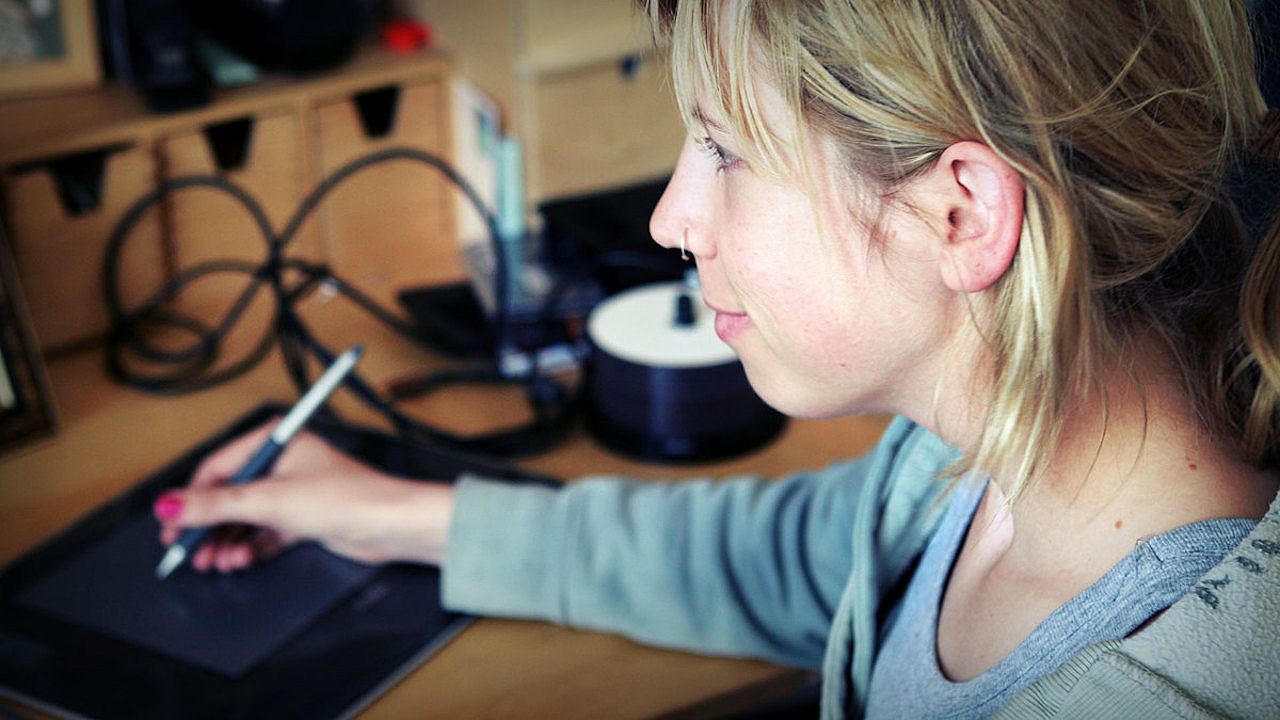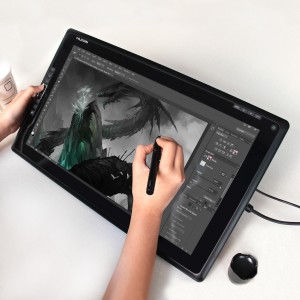Big Idea: Digital Tablets
Jun 9th 2016

📢 Post updated August 2024!
Tablet vs Mouse
New digital artists often ask the question, "Why get a tablet when I have a mouse?" Perhaps tablets give the impression of being a luxury rather than a necessity. And depending on your interests, a tablet can be a luxury or a necessity.
Who is the tablet for?
Tablets are most useful for certain disciplines: Digital painting, 3D modeling, 3D sculpting, and texture painting are the obvious candidates for a tablet. In fact, for those I would say a tablet is necessary. For other disciplines like rigging, animation, dynamics, and compositing, a digital tablet isn't as much of a necessity. Having said that, I've known riggers and animators who use a tablet exclusively. I've also known modelers who use a mouse exclusively. So we're not really talking about a right or wrong here. A tablet can be for anyone who wants to interface with the computer in a more natural, pencil-and-paper kind of way. Even though there's subjectivity involved in choosing a tablet or mouse, there are some objective benefits of a tablet over a mouse:
- Pressure Sensitivity: Tablets offer the ability to alter input based on the pressure of the pen against the tablet surface. This functionality has tremendous benefit when blending gradients in a painting or carving in digital clay; something a mouse cannot do.
- Tilt Sensitivity: Some tablets recognize the tilt of your pen to enable additional functionality that can't be emulated by a mouse. Think of when an sketch artist tilts a pencil to use the length of the tip for shading.
- Carpal Tunnel Prevention: While tablets aren't a cure for carpal tunnel, it does provide a more natural movement than a mouse. But the task variety of switching between keyboard, mouse, and tablet is beneficial for preventing carpal tunnel syndrome.
Kinds of Tablets
Of course there's a variety of choices in the world of digital tablets, as with anything. Some choices are simpler and budget-friendly while others offer the fanciest features and immersive interaction to make for the best artistic experience. Let's take a look at 3 tablet "classes".
CLASS 1: Tablet
"Intuos" by Wacom
This is the baseline class featuring a standalone tablet that offers no-look pencil-to-paper interaction. By "no-look", I mean the hand-eye coordination is like that of a mouse where you're looking at a computer monitor to see the result of your hand movement while your hand is actually moving out of sight. This kind of coordination can take some getting used to at first. But this class is the most affordable. The "Intuos" line fro Wacom is one of the most popular standalone tablets.
This is a good entry-level tablet class for digital artists who want the baseline benefits of a tablet. They're great for 3D modelers and sculptors.
CLASS 2: Tablet + Display
"GT-185" by Huion
This class eliminates the hand-eye coordination problem by making the tablet surface a computer monitor itself. So it's like drawing "on" a digital canvas, making for a much more natural interactive experience for digital artistry. Some consider it to be a negative of this approach that your arm covers a portion of the screen as you work - Traditional drawing and painting have the same problem. Brings back memories of graphite palm from my school years...The "Cintiq" is one of the most popular display tablets.
These are expensive tablets that are great for committed/professional digital painters and sculptors.
CLASS 3: Tablet + Display + PC
"Surface Pro" by Microsoft
This class offers the full package of being a tablet and display and computer. It's like having a digital drawing notebook in your backpack anywhere you go. As you can imagine, tablets like this are expensive. But they're growing in popularity thanks to an expanded manufacturer pool including Apple and Microsoft.
Brands
There are many companies offering tablets, but here's a few key players.
- Wacom - Leading tablet manufacturer offering all 3 classes. They've been around the longest, offering decades of reliable hardware and software, and tend to be the most expensive in each category.
- Huion - Quality manufacturer offering all 3 classes.
- XP Pen - Budget tablet manufacturer of class 1 and 2 tablets with an Android-based option for class 3.
- Gaomon - Budget tablet manufacturer of class 1 and 2 tablets with an Android-based option for class 3.
- Apple - iPad Pros qualifies as a class 3 tablet with a highly-praised user experience. However it should be noted that the iPad Pro runs iOS and AppStore apps instead of a desktop OS, meaning Blender is currently unavailable.
- Microsoft - Not to be outdone by the competition, Microsoft too has entered the tablet market with their class 3 Surface Pro.
What We Use
"I currently have a refurbished Intuos Pen & Touch model from Wacom. Before, I used a Bamboo Fun ($80 back in the day) that lasted 8 years and never stopped working. Moral of the history: Wacom is a quality brand and I get along fine with class 1 tablets." - Kent Trammell"I've used three tablets, all Wacom brand. I started with an old hand-me-down Intuos 1 or 2 (I don't remember which). After a few years of fiddling with it I upgraded to a Intuos 4 Medium, which is the tablet I still use today. For a while I added a 13in Cintiq but ended up selling it as I was no longer sculpting every day and preferred the ease of which the Intuos 4 could be slipped into my backpack." - Jonathan Williamson"I really enjoy using my Medium Intuos Pro when I'm working at my desk, but I've been using my Surface Pro a lot more because it's so portable. It has a solid drawing experience and can run full desktop apps like Photoshop and Blender, which makes it much more useful than a normal tablet or a normal laptop." -Jonathan Lampel"While I was in college I owned a Bamboo and since then have owned a Wacom Intuos 3 and 4, a Cintiq 13HD, and most recently a 22 Cintiq Touch. Based on my experience, I believe that all tablets function in a very similar fashion it just comes down to personal preferences. These can include the grip feel of the pen, the surface of the tablet (glossy or matte), the buttons available on the tablet, or even the most obvious preference: the size. I've found that working with a larger size feels closer to a traditional experience and using a cintiq has proved beneficial in terms of working with more precision and control, especially with edges or line work. The touch features feel natural and while they don't always respond at first swipe, I've found myself using the zoom in and out feature a lot during the duration of my paintings. If you can test one out before buying one, a large comic convention is bound to have a Wacom station or a booth with cintiqs on display to use. So before rushing into one, I would recommend testing out a few of them first to find the right fit for you!" - Tim Von Rueden (vonn)




I use a simple Wacom Bamboo whenever I'm on the computer, not just for Blender. It seems to much more precise to use a pen rather than a mouse. Using a mouse all day caused a strained tendon in my wrist a few years ago so since then I've been using a tablet every day, all day.
A pen seems to much more natural to hold that it's only if I've done a full day of something particularly strenuous that I'll feel any kind of mild strain, but it's nothing like I would have felt with a mouse.
The only disadvantage of using such a basic Wacom model is the lack of any kind of express keys or touch control to replace the scroll wheel of a mouse. Luckily in Blender I don't have to use the scroll wheel much, but I do have a mouse on hand for times that I do. Other than that the basic Wacom model is a great piece of hardware, so you don't necessarily have to spend a lot to get a good tablet.
The Cintiq get hot overtime and my hand cover what I'm doing. Overall the cintiq isn't ergonomic tablet to me at least.
I use an old Wacom Graphire Tablet (Model ET-0405-U). I use it in Photoshop for painting and in Blender when texturing and 3D-modelling. I'm amazed that I still got it to work on my PC when i upgraded to Windows 10 a few months back!
I have been looking to replace it with newer model a few times, but I've always decided to keep using this old piece of hardware. It had earned my respect. :-)
thanks for the reply would love a cintiq companion but fond of having two arms lol Trying to balance functionality and budget just wonder if anyone's had good luck running blender on a tablet or 2 in 1 under a grand.
Convertibles are great, but unfortunately the drawing experience is downright clunky on the large majority of them. The Cintiq Companion and Surface work quite well though, so you might want to look into those.
It sounds like the Cintiq Companion would be perfect! Alternatively, Microsoft and Wacom are working together so that it should eventually be possible to use a Wacom pen with a Surface in the future.
As always Kent, good one. I still use my Wacom Intuous 3 but recently purchased two Parblo tablets, may consider their display unit ... great price at Amazon and great performance.
My tablet http://parblo.com/parblo_a610_detailpage
Considered Pen Monitor http://parblo.com/parblo_coast22_detailpage
Really nice article. I have Wacom Cintiq 21, Intuos 3 and pro. I stopped using the Cintiq, now I just using the Intuos pro. (The Cintiq just to collect dust)
My friend uses the app called Astropad, which is pretty much a remote desktop, and can turn your iPad Pro into a Wacom tablet. But you need a computer with Blender installed.
Another *major* benefit of a tablet over a mouse is that it drastically reduces the strain on your wrist and thus the risk of developing RSI. I've had a severe case of RSI a year ago (I basically wasn't able to use my right hand at all at the worst point) and haven't touched a mouse since. I'm using a large Intuos Pro tablet for everything (modelling, sculpting, browsing, office work) and although it takes some (maybe a lot) of getting used to at the beggining it's absolutely doable and I can only recommend it to anyone.
Developing RSI can be quite scary if you work with computers all day, up to the point that you fear for your carreer, there are lots of people who had to quit their jobs because they couldn't use computers anymore - if you experience any warning signs at all (e.g. your hand hurting after working/playing games for a couple of hours) don't ignore them and start doing excercises and taking micro breaks right now before it's too late, you might not get rid of it again once you've developed it. I ignored all the warning signs when I had them (partly because I didn't recognize them) and wouldn't wish RSI on anyone.
TL;DR: Get a tablet right now if you plan to do a lot of fiddly stuff on a computer, it saved my wrist!